“...it is virtually necessary that observations and studies continue. This is not a phenomenon in which we are spectators and not experimenters. We have to await the pleasure of Nature and maintain a constant vigilance.”
A number of bright aurorae have been observed from the latitude of Sydney. Some ‘Historical Aurora’ in New South Wales. Some examples (which I’m still researching include;
02nd March 1947; A bright aurora was observed in Sydney. It happened to have occurred while three by CSIRO astronomers were testing and recorded radio signals, that were also setting up equipment to listen to the highlights of the 5th Cricket Test between Australia and England. This was a much discussed topic prior to the beginning of the third day. The aurora was bright enough to be seen by a newspaper reporter who saw its light from the centre of Sydney. He apparently was so enthused, that he when into the Botanical Garden (to the east of the city) so he could get a better view!
I have also collect about half-a-dozen reports since 1899. Two apparently occurred four weeks apart in June 1935 (the cycle before), another in 1923, and a fainter one in 1911.
I you have any relevant information on these (or other) observed aurorae seen from around Sydney please contact me ANDREW JAMES. Either I will put our words here (if you wish) or collate them for a more extensive study.
Several have been seen in recent years.
The phenomena these days is not seen in the city skies because of severe light pollution, though at least a recent one was even seen as close as five kilometres from the Central Business District C.B.D. Aurora in the Sydney area are seen from the outer suburbs, often favouring the southern parts which have no major cities ecept for Canberra some 200 kilometres to the SSW. Those in the Blue Mountains about 80 kilometres of the city also have the advantage of seeing aurorae though are likely more prone to being clouded out. Those west of these ranges have a much better change being under very dark skies. Many astute observers have commonly reported seeing faint glows or suspicious auroral activity in the southern skies. Disappointingly many of these observers don’t report them - leading to auroral observers in our clines to not having a reasonable idea of auroral frequency. (If you do see one, or suspect you seen one, please report this to me, or preferably, seet in to the RASNZ’ ‘Aurorae and Solar Section’
The following examples are of aurora seen in the last thirty years or so - many I can recount first hand or from reliable observers I personal know and can vouch for. Of all the aurorae in this time, around 1981-82 proved particularly good years, with three major outbreaks. This also corresponds near the observed solar maximum. A very prominent aurorae, likely the brightest in the last century or so from this latitude, was also observed in 1990. Another brigther more southern aurorae was observed from Melbourne on the 26th March, 1990.
ENJOY!
This was a very prominent aurorae, some 30o above the southern horizon. The aurorae was distinctly reddish, and began immediately the sky had become dark. It appeared in three distinct waves in a period of about 3½ hours, with the second increase the brightest. The aurorae was seen as a curtain, some 20o to 25o above the horizon, being about 30o in height. The curtain was defined by brighter red or white rays, that moved by oscillating closer and then further apart in a period of several minutes. Through the display, stars could easily be seen, extinguishing perhaps two to three magnitudes during maximum intensity. Some of the stars took a reddish tinge through the aurora. Not many mentioned any observations from the inner city, though some south of the city reported that the though they saw a ‘fire’ to the south of their location. Some, like the Sunday Telegraph under ‘Lights Over Sydney’ on the 15th, reported that some people thought their was a U.F.O. invasion, though the paper certainly overstated the facts for the sake of journalist sensationalism. The paper reported that the explanation for the phenomena was either “...the lights of the Sydney Cricket Ground reflected off the clouds” (Note: It was perfectly clear!) or the correct explanation, “...electronic effects of the Aurora Australis in the very upper atmosphere.” Apparently, the Weather Bureau and the local Police Stations in Katoomba, Penrith and Lithgow were inundated with phone calls, reporting “balls of red fire”. in the sky The local constable in Penrith, Uri Adamson, reported seeing a “fireball” that was “...travelling at tremendous speed”. It is unsure if he did see a fireball or the actual aurora.
This aurora was observed to start at about 8.40pm on the first night in May. The initial appearance was reported to be red-orange, though most described it as reddish in colour. Most unusual were a series of streamers, that were pulsating in intensity in a period of about 30 seconds. The aurora intensified in the next 20 minutes, reach a maximum height of about 65o above the southern horizon. Later the streamers intensified, emanating from below the horizon, with some reporting streamers like ‘searchlights’. Some saw some ‘fanning’ of the streamers, radiating away from a small point close to south. The aurora was last noted at about 11.15pm, though most observers did not see the entire event, due to cloud cover over the eastern seaboard. The aurora was particularly prominent from Melbourne, who had cloudless skies.
This was a reddish glow (typical colour for aurorae at ‘high’ magnetic latitudes) seen in the direction of the south and south- west. Starting at about 7 pm., the aurora burst to cover the entire sky to the south, reaching almost to the zenith. The far south was noticeable bright red, fading till it was hardly distinguishable near zenith. 10 minutes later, several parts of the aurorae, at an altitude of about 40o, were several pulsating parts changing to a lighter red colour. A number of rays were also noted, emanated almost exactly due south. Over a period of three hours, the entire aurorae pulsated in to three main displays, finishing around 10.15 pm, before disappearing. This aurorae was also reported by John Glossop in the ASNSW “Universe” in November, 1982. No serious reports were made in the local papers, except for a small section in the Sydney Morning Herald the following morning.
When the Aurora Australis was observed on this date it was one of the most spectacular in recent memory. In the course of three hours in flared brightly in three separate phases. For observers from the latitude of Sydney (-34oS) such auroral events are very rare, happening perhaps once or twice per decade or so. In this case my friend and me happened to be at the right place at the right time. Even more fortunate was that Nick was a good photographer, and he produced the images you can see throughout this page. Exposures here were around forty seconds, which is just long enough not to saturate the film with light and short enough so that the star trails from the Earth’s rotation are minimal. Our knowledge on this night was certainly enhanced by my trip to the RASNZ Conference in New Zealand about seven weeks prior to his date. In New Zealand’s South Island the southern aurorae is far more frequent, and one of the papers presented was on the aurorae and taking how to take photographs of the phenomenae. Fortunately I had listened carefully to the talk - so my knowledge on this night was both fresh and clear in my mind. Soon enough I was spouting facts like an expert- even though I had only experienced an aurora only eight years earlier.
The ‘unexpected’ aurora was first noticed only as an odd bright yellow-white glow near the horizon at around 8.00pm. By that time I and my friend Nick were having a coffee break after our first two hour round of general deep-sky observing. Our vantage point was from our usually selected and isolated dark deep-sky observation site near Mt Banks in midst of the Blue Mountains about eight-five kilometres west of the CBD of Sydney, at least, as the crow flies.
It was first thought to be a just an unusual glow from the Katoomba area by me. I made several comments that continued over about twenty minutes. In a minute or two, and much to our surprise, a spectacular auroral display erupted over almost the entire southern sky, which at times very nearly reached as high as the zenith.
To the south the red colour had intensified, and the aurora now appeared as a general glow. Towards the direct south and 40o either side in azimuth of the southern horizon, to a height of perhaps 5o-10o, a dirty yellow colour was seen near the horizon. Above this arc was a distinct blue colour that extended another 10o-15o. The Southern Cross, appearing as a dropping kite, was within this area, with perhaps roughly 1 to 1.5 magnitude extinction. (Fig. 1)
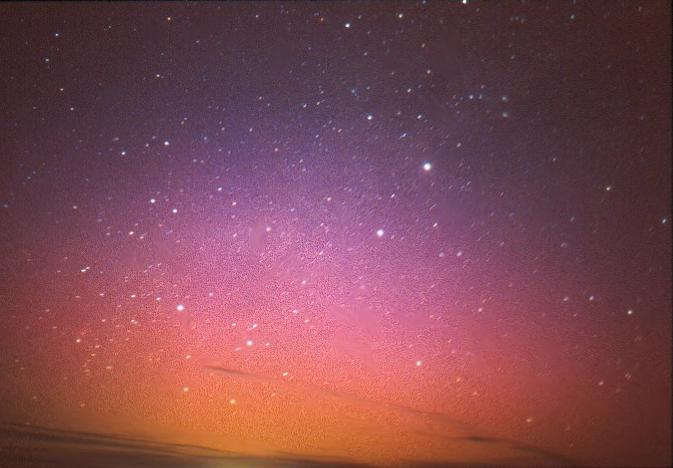
There was slight lull in the aurora for about twenty-odd, minutes. This went with a slow but perceived diminishing variation in colour to the reach the usual reddish hue.
Initially the colour was a deep rich red that continued to brighten over about twenty minutes. To the south and south east showed the greatest intensity of the red glow, with several parallel rays, down to the horizon. The glow cast a dull reddish colour on the ground that surrounded us. This continued until about 9.00 pm, until it started to fade slightly.
By 9.30pm the auroral activity flared again, this time towards the west to south-west were the crescent Moon was beginning to set. First a bright series of white rays of light was seen down to the horizon, seemingly piercing out of the ground towards the heavens. (Fig.2.) The rays were seen to be inclined at an angle of about 70o from the horizon towards the north. They also pierce the entire constellation of Scorpius and Sagittarius, that could be just seen through the auroral light - dimming the light of the Milky Way somewhat. (Fig. 3.)
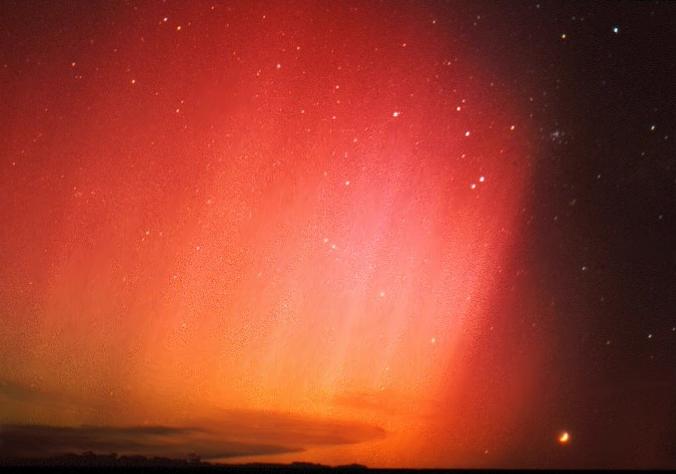
The rays were in slow motion, and several dozen of them pulsated over a few seconds for a period of two or three minutes. (See Fig 3.) The brightest even one intersected the Moon, that continued until it had set, with the ray phenomena fading from view, some ten minutes later, at 10.10pm.
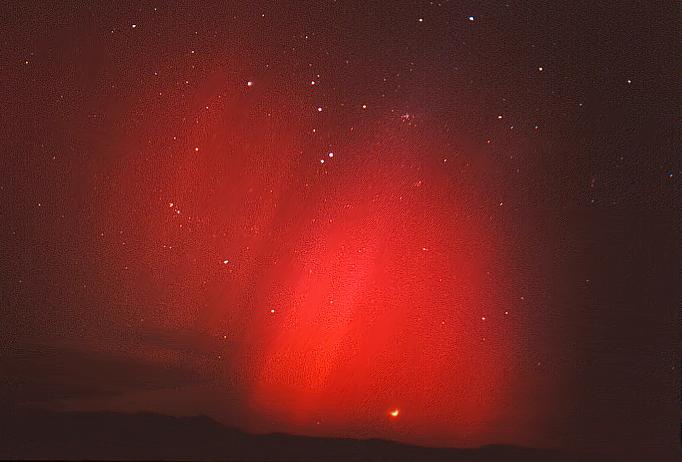 ,
,
Above this position, up to about 10o of the zenith, the colour turned into an intense red, and by 10.10pm to 10.20pm had increased enough to cause the ground top again appear as a dull red colour. (Fig. 4.)
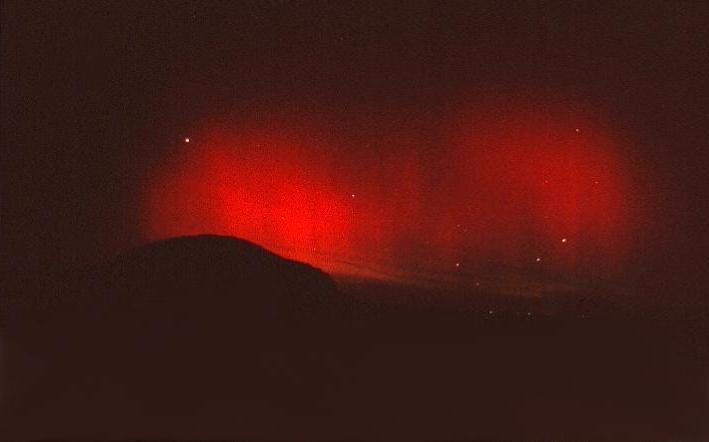
Within a few minutes (10.20pm) the red glow had begun to appear as three separate colours that grew in intensity. Even some faint rays could now be seen almost emerging from the horizon. These whitish or bright red rays were tilted at an angle of 5o from the perpendicular, each extending to a height of about 50o above the horizon.
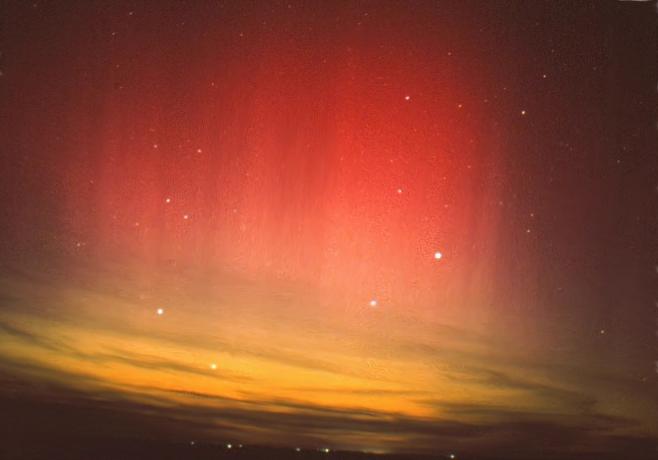
The intensity of the rays changed slightly as so did the colours. Same overall movement was perceived to oscillate in an east-west direction, and the aurora moved in an easterly direction.
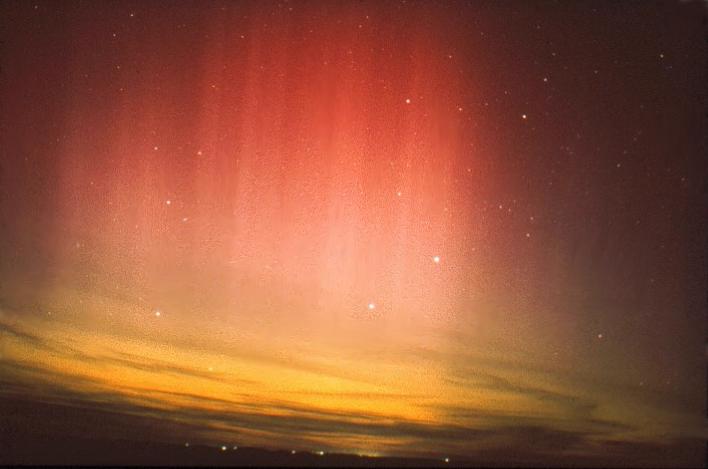
By 10.30pm, the aurora contracted towards the south and west,
leaving a faintly glowing red colour in the sky, that was
without much form or structure.
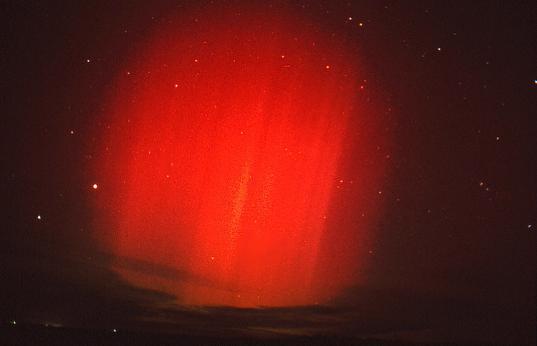
The aurora flared for the third and final time at around 11.00pm, though not as intense as the first two bursts. Its height extended about 40o and appeared as red glow, that brightened and became a slightly lighter red. The direction of the faint rays were now opposite slant than in the second major outburst. This last final hooray was shorter that only lasted for about twenty minutes.
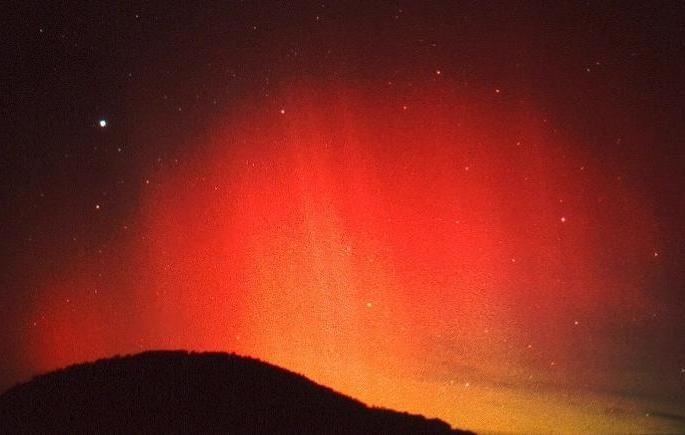
Soon the sky returned to the its usual darkness. I suspected, using adverted vision and comparing the northern sky to the south, that a very faint red glow persisted until about 12.30am. By that time we had begun to packed up and headed for home.
This aurora was reported on radio and the newspapers the next day. The fire brigade and the weather bureau reported a inundation of phone calls. Areas away from the city sky glow had the best view and the reports, especially south and south-east of the city produced the most of the phone calls. Most thought the phenomena was a very large bushfire to the south of the Sydney. The radio stations reported the phenomena. (I actually had an interview on radio with 2UE at 3.50am.) The aurora descriptions from other observers indicated the observations were widespread. Reports came from a far south as Tasmania, Melbourne, most of Eastern Victoria and a far north as Coffs Harbour.
On an early late-winter Sunday morning, an aurora was seen in the southern half of New South Wales. The activity was seen over twenty minutes or so before fading from view. The aurora australis was a typical bright red colour. One report of observations was posted to the A.S.N.S.W. Yahoo! Group, which was made by five members of that Society from the property known as Wiruna, 200-odd kilometres northwest of Sydney.
“It was quite bright red in colour and extended from the southern horizon to just below the SMC and LMC.”
This was the third bright Aurora that was seen during the maximum of the current solar cycle, and considering the sun’s activity around this time it was not surprising.
’When we got to the northern side of the observing field the aurora was very bright in the southern sky. It spanned about 20-25odeg. across the southern horizon and about the same distance above the tree line,which was about 10o high, from where we were standing. The aurora seemed to be made up of about 10 equal sized columns stretching from the horizon up towards the Magellanic Clouds. This gave it an appearance similar to vertical blinds.The colour was mostly a muddy red with traces of blue and green in the columns at either end. A slow rippling could be seen moving through this red curtain. After about 15 minutes it gradually contracted towards the horizon changing colour to a very pale blue-green and spreading to about 30-35o along the southern horizon and then disappeared completely... This one was certainly...impressive, seen from the still dark skies of Wiruna,with the Magellanic clouds sitting above it.
If anyone managed to photograph the aurora I hope they will post the images or a link to a website so that the people who went to bed early get to see what they missed.”
Another bright aurora was observed on the 23rd October from Sydney and southern towns of Woollongong and the southeast of New South Wales. This event was close to the southern horizon and displayed the usual red aurora with ray structure and a green mass of light below it stretching about 5 or 10 to the horizon. The flare-up start around 9.30pm, which continued until about midnight.